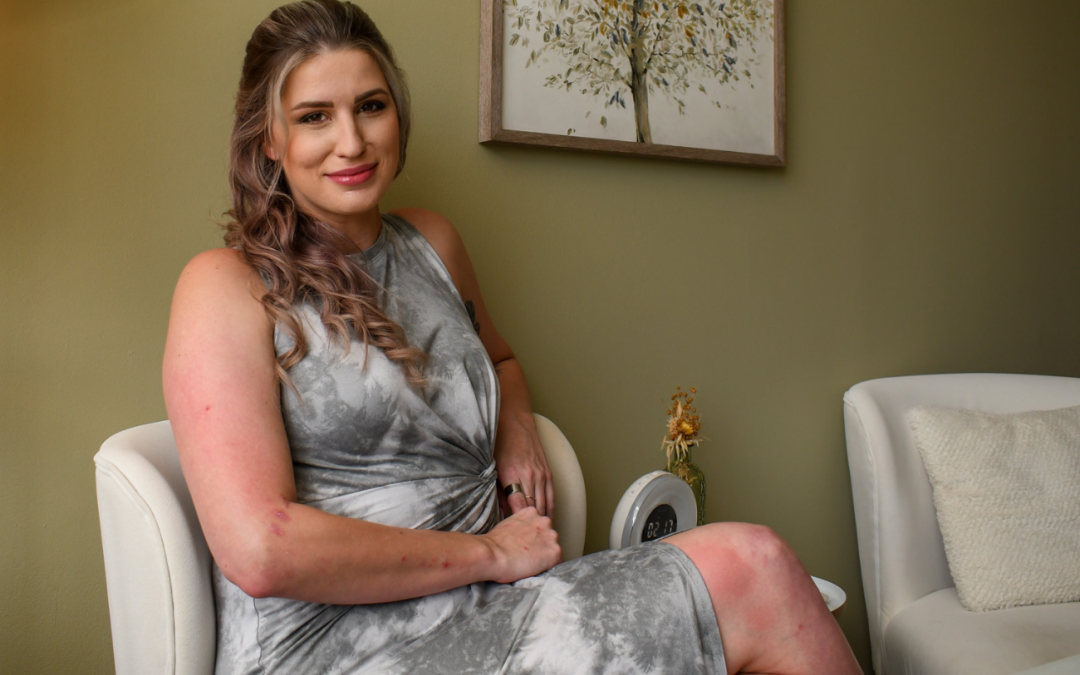By Kat Eftink
Ever feel like traditional talk therapy isn’t quite working for you? If you’re looking for a more creative approach to healing, you should give art therapy a try. Caitlin Leggett, a licensed professional counselor and art therapist (ATR, LPC-MHSP) uses art to help clients explore their emotions and navigate mental health challenges. In this Q&A, Caitlin dives deep into art therapy, explaining its benefits, applications, and how it can help you find a new path to self-discovery.
Q&A With Memphis Art Therapist, Caitlin Leggett
KE: What does art therapy look like?
CL: One of the biggest takeaways and something that I always have to drive home with my clients, especially the ones that are not super familiar working with art materials or feel kind of nervous or self-conscious, is that it’s always about the process and never the product. So the goal is not to make something that looks pretty, or looks good, it’s a vehicle for self-expression, for processing things.
So depending on what we’re focusing on, I might give somebody a very specific prompt, you know, think about this while using these materials. Sometimes I encourage them to do something specific. Other times, we’ll do what I call art as therapy which is where there’s no specific prompt. There’s not really any rhyme or reason to it. It’s just using and working with art materials themselves can be therapeutic, just like painting for the sake of painting.
KE: How does art therapy benefit people compared to traditional talk therapy?
CL: I find that some of the primary benefits of art therapy, and why it’s kind of this adjunct that helps push the work to go a little bit deeper or resonate in a bigger way than just normal talk therapy, is you’re tapping into these other parts of your brain.
Where you’re allowing yourself to be expressive and creative without necessarily having to use words, especially in cases of trauma. Sometimes people can have a really hard time verbalizing the experiences that they’ve been through, whether that’s because it’s just too painful to speak it out loud or go back there because trauma can sometimes cause gaps in memory.
Sometimes it helps just bridge the gap in that way. I find that for people who struggle being what I call a verbal processor, someone who’s able to very openly and succinctly tell you how they’re feeling and what’s going on. Not everybody can process their emotions and their experiences that way. So art therapy is a great way to just kind of bridge that gap so that I have a deeper understanding of how they think, and how they process what’s going on for them.

KE: Who could benefit from art therapy?
CL: Art therapy is so great because it can be applied to just about any mental health concern. Although a majority of my clients come in here with their primary concern being anxiety-related, I’ve worked with clients in the past who have had schizophrenia. I’ve worked with bipolar clients, trauma clients, ocd, low self-esteem, family conflict, and depression. You can shift it and mold it in such a way to where it’s gonna serve different clients for their different needs.
KE: How does local culture influence art therapy?
CL: I think having Memphis be such a culturally rich community with art and music makes it feel a little bit more appealing or accessible to clients that come in here. We’re able to talk about things that are local and relatable, that have to do with the arts–whether it’s theater or cool murals that we’ve seen downtown…You know, my grad school professor would call that like operating through the lens of an art therapist without actually using art.
KE: What advice would you give to someone who is considering art therapy?
CL: I always encourage people who are new clients that are on the fence or unsure about the art therapy practices: there is always no pressure. This is meant to be a safe healing practice. It’s not meant to put anyone on the spot or make them feel bad in any way.
I always remind clients that we go at your own pace. If I suggest a prompt and say, ‘Hey, would you be interested in trying this today? I encourage them if that’s not what they’re feeling, if they want to focus on something different, or if they’re just not in the headspace to do that, tell me no. You know, we don’t have to do that.
I think it’s really important for people to feel like they have a sense of empowerment and choice when they’re participating in this, rather than it being this pressured thing.
Art therapy isn’t just about creating masterpieces; it’s about reconnecting with that playful, creative side of ourselves that often gets pushed aside as we grow older. As Caitlin mentions, many people abandon art due to fear of judgment or lack of immediate proficiency. But art therapy provides a safe space to embrace that creative spirit again. So, if you’re curious about exploring your inner artist and finding a unique path to healing, give art therapy a try. You might be surprised by what you discover.


